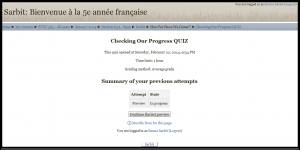 Task: Reflect upon your experience completing this assessment tool. Cite relevant literature to support your pedagogical decisions, specifically related to creating questions.
Task: Reflect upon your experience completing this assessment tool. Cite relevant literature to support your pedagogical decisions, specifically related to creating questions.
I chose to create a formative assessment that could “identify what a student knows and what they do not” (Gibbs & Simpson, 2005) on the first four modules or topics of Core French 5. This choice was made (as opposed to creating a more summative assessment) for multiple reasons. First, these students are beginner second language learners as this is their first experience with the French language. This will naturally lead to some anxiety and therefore assessing them more regularly will cut down on the amount of material per assessment. Gibbs and Simpson (2005) support this claim by stating that more frequent assessment tasks result in happier students, higher results and can in fact be better predictors of long term learning. Furthermore, the purpose of this assessment for me as the educator is to provide me information on student learning so I can “guide my planning for future instruction” (Alberta Education, 2009).
Student achievement has been shown to increase when the Multiple Intelligence theory was employed in some capacity in second language learning assessment (Haley, 2004)Within the assessment I have created (which can be seen here) I have used a multitude of different types of questions including multiple choice, matching, short answer and short essay questions. By varying the type of assessment question, I hope to reach different learning styles. Additionally, some questions are presented in French (and students are asked for the English translation) while others are presented in English (and students are asked for the French translation). In this way, I hope to include students who learn in different ways. Also, the questions in this quiz have been designed to mimic those asked in the classroom and throughout the online modules. This way, the content is assessed in the same manner it was taught, thus making the assessment less threatening (Alberta Education, 2009).
Feedback has been found to often not read at all (Hounsell, 1987) or not well understood (Lea & Street, 1998) or utilized. I have designed this quiz in a way where students can take it more than once (provided they wait 24 hours between attempts). It is designed to provide feedback (and links for extra practice) to students if they answer a question incorrectly. Therefore, they then have 24 hours to review the material (as opposed to simply trying multiple times in a row hoping to get the right answers) and then they may assess themselves again. Questions are randomized, so students writing a re-quiz will have different questions all modeled around a central format. My hope is that allowing them time to review will force students to engage with the immediate feedback provided and use it to guide their review and learning.
I enjoyed the process of creating this quiz as it forced me to reflect on my current classroom assessment practices, not only for their structure, but also for how they make students feel (in regards to test anxiety, providing adequate preparation time etc.).
References:
FSL Guide to Implementation. (2009) Alberta Education, Canada. Accessed: https://education.alberta.ca/media/1111945/ch8.pdf
Gibbs, G. & Simpson, C. (2005) Conditions under which assessment supports students’ learning. Learning and Teaching in Higher Education Accessed: http://www.open.ac.uk/fast/pdfs/Gibbs%20and%20Simpson%202004-05.pdf
Haley, M. (2004). Learner-Centered Instruction and the Theory of Multiple Intelligences with Second Language Learners. Teachers College Record. 106(1). P.163-180.